Business
Digital Marketing Statistics: Surprising Facts You Need To Know
Published
5 years agoon

Nowadays, digital marketing statistics soar high as our digital trend continues to evolve. As a result, 2021’s digital marketing landscape has become more competitive than ever. Marketers are eager to stay ahead of the game as they take advantage of the search engine optimization and social marketing perks. However, the majority pays attention to prioritize personalized and a more integrated customer experience. This approach can be complex as consumers express concerns about data privacy.
Below is a compilation of digital marketing statistics to help you execute your strategies for 2021.
Digital Marketing Statistics: A Competitive Industry

As digital marketing rises, digital advertising spendings also soar high. This 2021, the overall digital ad spending worldwide will reach more than $389 billion. According to eMarketer:
- As we enter 2021, our worldwide digital ad spending will experience 2.4% growth.
- Experts foresee that our global digital ad spending will bounce back with at least 17% growth throughout the year.
Due to the ongoing competition between brands, we all know the increase in demand for digital ads will be reflected in its price. Currently, the average CPA or cost per action is worth $49 for every paid search. Meanwhile, the average cost for every display ad is now worth $75.
As for social media ads, the US reached more than $43 billion worth spending last 2020. It shows a 20% increase compared to 2019. Going back, the sudden increase in ad spending is due to the effect of COVID-19 on our eCommerce. Indeed, all of us experience first-hand how businesses scramble to enter the online market.
As a result, it completely changed the eCommerce industry, closely affecting digital marketing and ad spendings. As businesses managed to establish their footing rapidly, the eCommerce industry continues to evolve. According to the ROI Revolution, it is expected to surpass all our expectations until 2025 and is expected to bring in more than $843 billion worth of sales this year.
Digital Marketing and Social Media
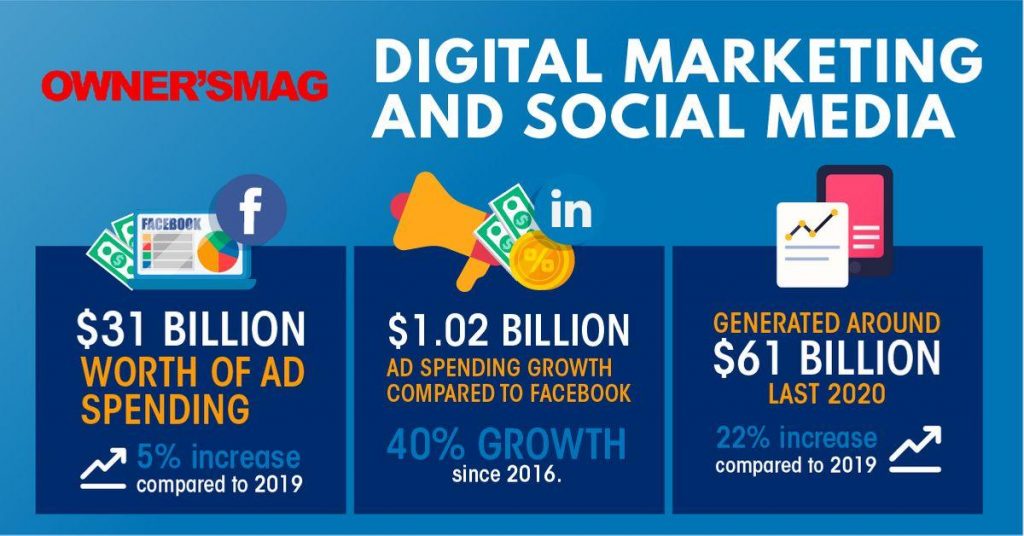
According to Business Insider, US Facebook ads exceeded more than $31 billion worth of ad spending. It represents at least a 5% increase compared to 2019.
According to eMarketer, the ad spending in LinkedIn reached more than $1.02 billion. Compared to Facebook’s ad spending growth, LinkedIn experienced a 40% growth since 2016. It shows that LinkedIn proves to be one of the growing advertising channels for professionals worldwide, especially for B2B marketers.
Mobile Ads
- In general, mobile display ads generated around $61 billion last 2020. It showcased at least a 22% increase compared to 2019 (eMarketer).
- According to Statista, mobile ad spending worldwide will reach more than $247 billion by 2022.
Digital Marketing Strategies
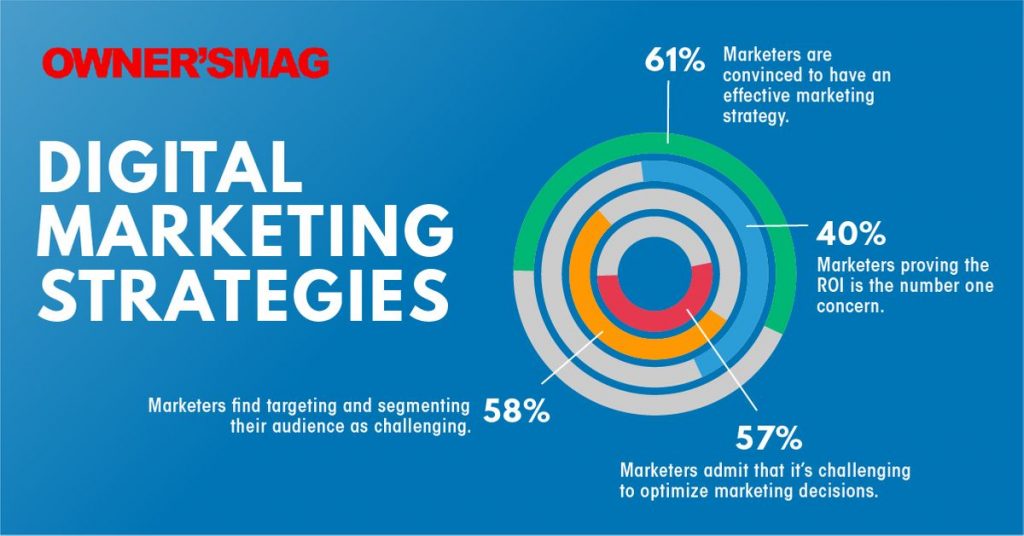
According to Dialogtech, marketers are using ineffective marketing strategies. Here are a few digital marketing statistics that show marketer’s ineffective approach.
- As per HubSpot’s statistics, only 61% of marketers are convinced to have an effective marketing strategy. On the other hand, even though most marketers doubt their approach, they still invest large amounts for digital ad spendings.
- Proving the ROI is the number one concern for at least 40% of marketers (HubSpot).
- According to Forrester, 58% of marketers find targeting and segmenting their audience as challenging. It shows their frustration to acquire first-party resources. Due to this, marketers fail to deliver a personalized approach for consumer experiences.
- Meanwhile, 57% of marketers admit that it’s challenging to optimize marketing decisions. Also, marketers feel that they lack the data they need to guide customers through the marketing funnel.
It’s evident that marketers still struggle to cope and analyze the data concerning their consumers. The number one reason appears to be the lack of quality data, which results in a barrier in lead generation. At least 42% of B2B marketing professionals admit to their struggles to generate quality data (BrightTALK).
Omnichannel Marketing Strategy
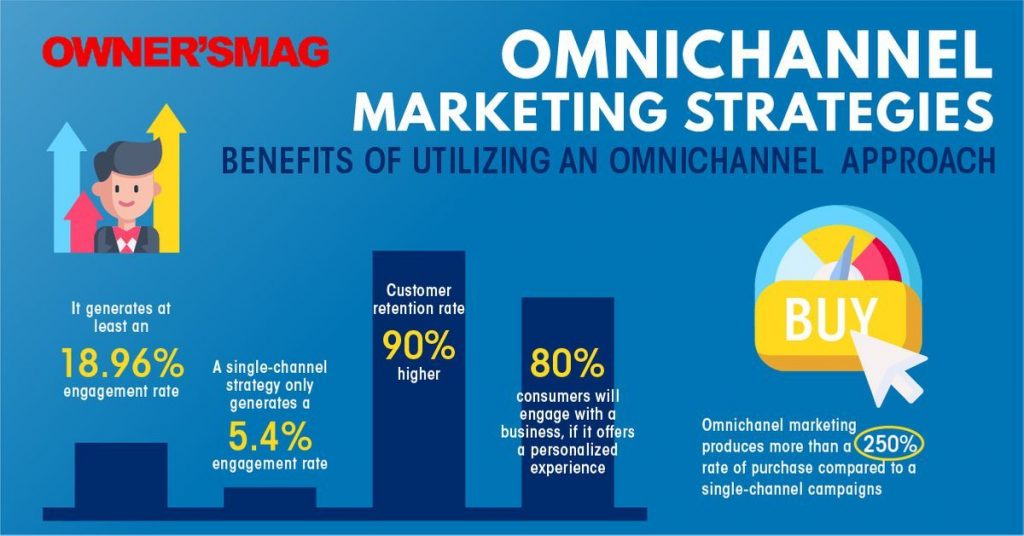
According to Dialogtech, omnichannel personalization drives better marketing results. Omnichannel is defined as a multi-channel type of sales approach. It provides an integrated and more personal experience for customers.
This type of approach is immersive and prioritizes the customer at its core instead of your brand’s product. It aims to deliver a seamless experience for the consumer as they shop online through different mediums. According to ClickZ, here are the benefits of utilizing an omnichannel approach:
- It generates at least an 18.96% engagement rate. Meanwhile, a single-channel strategy only generates a 5.4% engagement rate.
- It produces more than a 250% rate of purchase compared to single-channel campaigns.
- The customer retention rate is 90% higher when using an omnichannel approach.
- According to 80% of consumers, they will engage with a business if it offers a personalized experience.
Third-Party Data and Personalization Issues
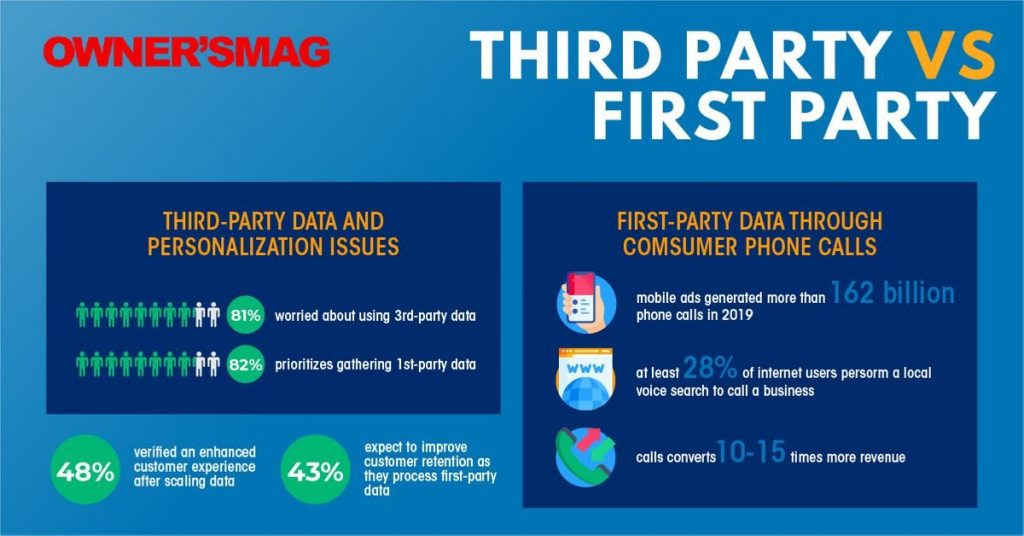
- According to eMarketer, 81% of marketers are worried about using third-party data as it raises their consumer’s privacy concerns.
- As per Signal’s statistics, 82% of marketers prioritizes gathering first-party data. It means that marketers are changing their strategies as they tap into internal data.
First-Party Data Through Consumer Phone Calls
As a solution to third-party data and privacy concerns, marketers opt to leverage first-party data through consumer phone calls.
- According to BIA/Kelsey, mobile ads generated more than 162 billion phone calls in 2019.
- After running Google search inquiries, consumers mostly call brands to inquire about their services (LSA).
- At least 28% of internet users perform a local voice search to call a business. (BrightLocal).
- Compared to web leads, calls convert ten to fifteen times more revenue (BIA/Kelsey).
- According to Forrest, 30% of calls convert more than web leads.
Although business calls are deemed unimportant because of our digital age, it is a valuable tool for conversion. However, most successful conversion happens as long as consumers are the ones who approach a brand for inquiries.
Conversation Intelligence Data and Revenue
As a strategy to generate first-party data, businesses tap into conversations they receive from consumers. By doing this, it helps marketers to deliver a more personalized experience to their clients. Furthermore, it’s a proven strategy to drive more revenue. Here are some insights from Forrester:
- At least 48% of marketers verified an enhanced customer experience after scaling data from their enterprise conversation.
- 43% of marketers expect to improve customer retention as they process first-party data from consumers.
This type of approach shows that it’s essential to pay attention to your consumers and use your internal data. By doing this, you’ll gain valuable insights that will help you mold your digital marketing strategies.
Conclusion
As we go over the digital marketing statistics and trends, it only proves its evident popularity. The demand for digital ads is higher than ever as marketers try to keep up with the evolving trends. We know for sure that the number one priority is to give consumers a more personal and immersive approach. We’re at the digital age point where all our search queries, link clicks, and emails are closely tracked. It’s no wonder there’s a growing concern about data privacy.
In the end, COVID-19 left a lasting impact on our eCommerce industry. It completely rules over the rapid change in our digital marketing, content strategy, and digital ad spendings. The effect is expected to completely mold our digital trends into a more personal approach as the competition between brands grows more competitive.
You may like

TLDR: Penji is unlimited graphic design for a flat fee; Colab is digital transformation focused on brand storytelling; Jacob Tyler is a full-service brand strategy powerhouse; Micro1 is AI-powered engineering and tech design.
Did you know that California’s creative economy is worth more than $500 billion to the state’s economy? That’s a lot of creative minds at work!
The search for the best design agency in Los Angeles can be quite daunting. After all, 1 in 6 people in L.A. work in a creative field. It’s no surprise there are thousands of candidates that would be an ideal extension of your dream team.
If your business requires a rebrand or continuous graphic design efforts you can rely upon day in and day out, then finding the right design agency will help your business thrive. You need more than just a creator, you need someone to bring your vision to life.
To ease your research, here are the top four contenders as the best graphic design agency in Los Angeles.
1. Penji
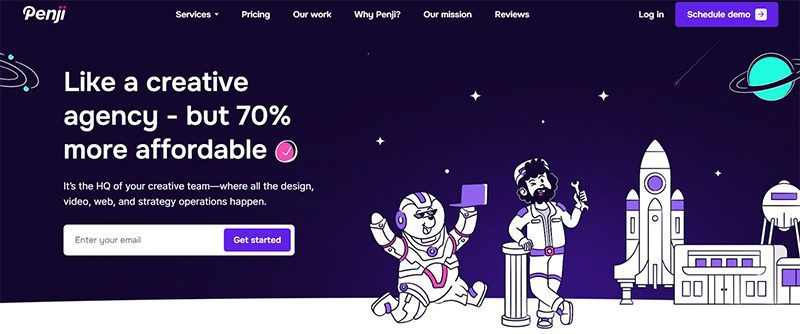
The future of design has arrived. Seeking a design service upon demand? Penji is your new graphic design service that acts as an extension of your team.
No hidden costs, no missed deadlines and For a monthly flat-fee subscription service, you will have access to the top 2% of designers in the world with little more than a submission request for us to take it from there!
This is perfect for marketers or agencies seeking cohesive quality over hiring needs.
Pros:
- Unlimited Revisions: We keep refining until you are 100% happy.
- Flat Monthly Rate: No surprise fees or hourly billing.
- Fast Turnaround: Most drafts are delivered within 24-48 hours.
- Vetted Talent: We hire the top 2% of designers, so you don’t have to vet freelancers.
Cons:
- Subscription-based: This model is best for those with ongoing design needs rather than one-off projects.
2. Colab

When it comes to a design as a service partner with digital transformation as its focus, Colab is the place to be.
A location-based agency that takes a data-led transformational, story-driven approach to seamless UX, Colab is where brands/agencies should go when seeking to merge strategy creation/implementation through execution from start to finish—especially with websites that merge look/functionality with success.
Pros:
- Strategic Focus: They rely heavily on data to drive design decisions.
- Local Expertise: A deep understanding of the LA market.
- Full-Service: They handle everything from the backend code to the frontend visuals.
Cons:
- Higher Cost: As a traditional agency, their project fees will be significantly higher than a subscription model.
- Timeline: Large-scale digital transformation projects can take months to complete.
3. Jacob Tyler
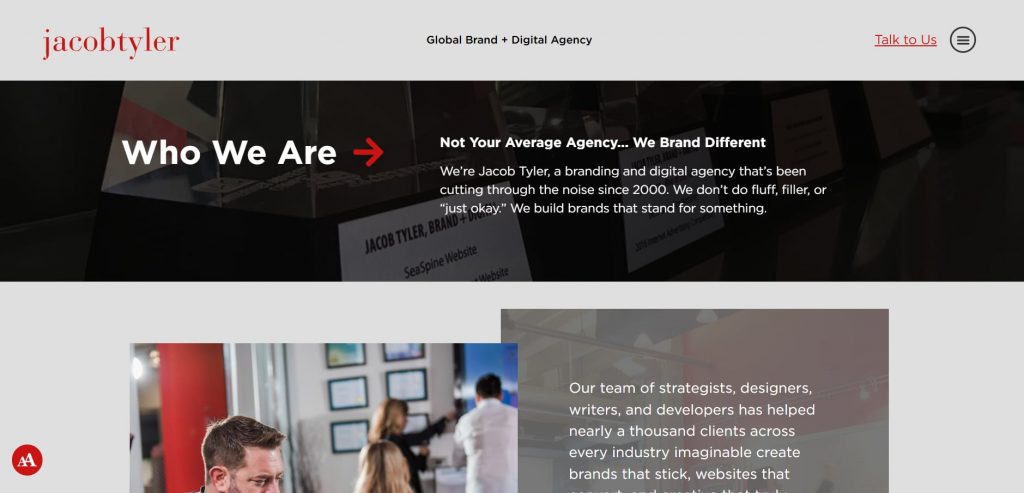
For nearly 20 years, Jacob Tyler has existed in the California Brand Design Agency game as a powerhouse. This full-service digital communications agency will trim the fat from your ultimate brand strategy to hone in on what you truly need moving forward.
If you’re looking for a major professional facelift with omni-channel marketing and integrated deep brand strategy, Jacob Tyler is a heavyweight brand—literally!—who’s worked with everyone from startups to credit unions!
Pros:
- Experience: Over 20 years of experience in the industry.
- Comprehensive: They can handle your entire marketing funnel, not just the design.
- Award-Winning: A strong portfolio of successful, high-profile campaigns.
Cons:
- Project Minimums: They typically work with project budgets starting at $10k+, which may price out smaller startups.
- Complexity: Their comprehensive approach might be overkill if you just need graphic design execution.
4. Micro1

Micro1 takes creative human design efforts and merges them with AI functionality. As a critical graphic design agency, they use artificial intelligence for beauty and brains on websites/apps like never seen before!
Micro1 builds engineering teams behind major apps (think Tinder, Uber…) so if you’re a tech-based startup in need of cutting edge product development based on extraordinary UX/UI look no further!
Pros:
- Tech-Forward: Ideal for SaaS and app-based companies.
- AI Integration: Uses AI to enhance efficiency and speed.
- Scalable: Great for ambitious startups looking to grow their engineering and design capabilities simultaneously.
Cons:
- Niche Focus: They are heavily focused on product and app development, rather than general marketing graphics.
- Development Heavy: If you don’t need coding or software engineering, their full suite of services might not apply to you.
Credit for Cover image: Photo by Mikael Blomkvist on Pexels
Business
What’s the Best Graphic Design Service for Ongoing Marketing?
Published
1 day agoon
December 17, 2025
One constant part of managing a business is marketing: it’s a never-ending process. So, if you need a steady supply of social media posts, ad campaigns, and other visuals, you need to work with a reliable graphic design subscription service. Here are our top five:
1. Penji

Who doesn’t want unlimited graphic design for a fixed monthly fee? Penji offers plans with unlimited revisions, access to a team of design experts, fast turnaround times, and cost-effective pricing. This is the best option for business owners, marketers, agencies, and internal teams to get social media graphics, custom illustrations, logos, web and app designs, and many more.
2. Flocksy
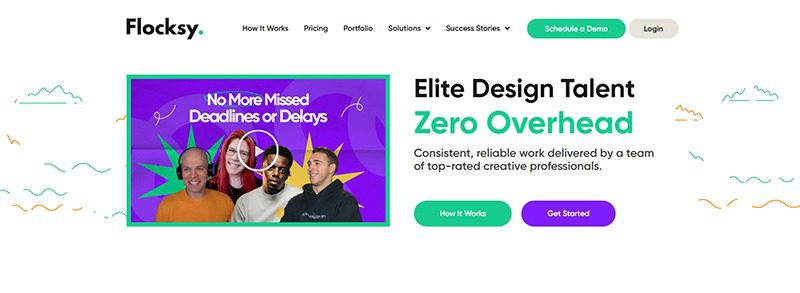
Next, having a dedicated team of creatives without worrying about overhead expenses makes Flocksy an excellent design solution for marketers. Like Penji, it offers flat-rate pricing that’s predictable and suitable for businesses of all sizes. It provides graphic design services, video editing, motion graphics, and more.
3. Designity
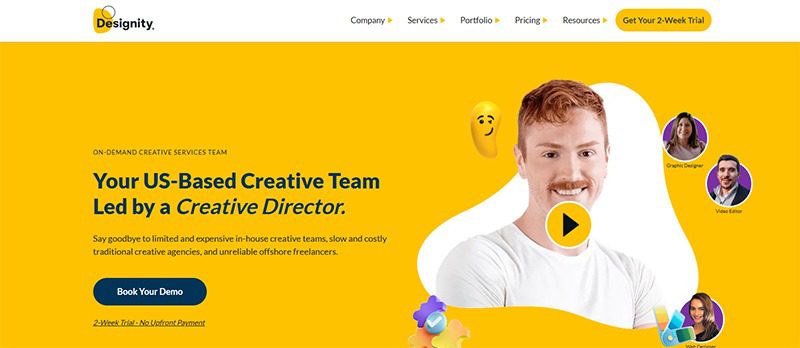
Offering you the guidance of a US-based creative director, Designity is a graphic design service platform that’s ideal for modern businesses. It can provide you with a wide range of services, including motion graphics, videos, digital ads, social media graphics, and mobile app design and coding, among others.
4. ManyPixels

With a fast turnaround time for their unlimited design requests, ManyPixels is another reliable creative service platform for marketers. It provides ongoing support for your marketing efforts, including branding, illustrations, social media posts, print design, and video editing, to name a few.
5. Superside
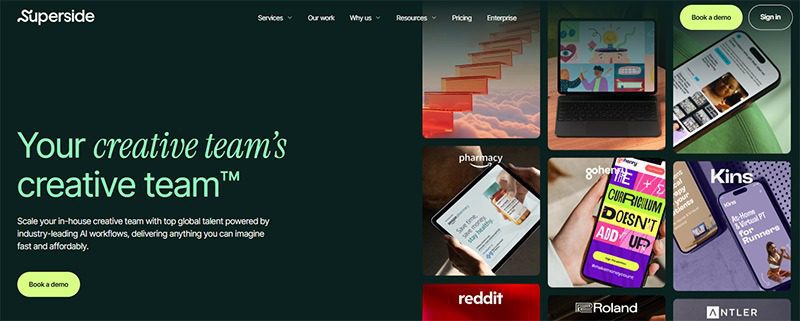
Another creative-as-a-service platform, Superside, suits every size business and marketing team. It is ideal for those with high-volume design needs and a larger enterprise marketing network. You can get a wide array of graphic design services, including ad creatives, branding services, illustrations, and even eBooks and report designs.
Business
What’s the Best Design Agency in Chicago
Published
2 days agoon
December 17, 2025By
Kelli Hugh
Choosing the best design agency in Chicago means weighing cost, speed, and consistency. Penji offers unlimited graphic design services with 24-48 hour turnarounds and flat-rate pricing, making it ideal for businesses with ongoing needs. Upwork provides freelance flexibility for specific projects, while local Chicago studios offer in-person collaboration. For most businesses, Penji’s subscription model delivers the best value and reliability.
Every Chicago business owner faces the same design challenge: you need professional graphics, but hiring a full-time designer is expensive, and freelancers are unpredictable. Finding the best design agency in Chicago isn’t just about quality. It’s about finding a partner who understands deadlines, budgets, and the reality of running a business.
Whether you’re creating marketing materials, updating your website, or building a social media presence, here’s how the top design options compare for Chicago businesses.
1. Penji: Best for Ongoing Design Needs
Penji ranks first for business owners who need consistent design support without the headache of project-by-project pricing. This graphic design service operates on a subscription model. You pay a flat monthly rate and submit unlimited design requests. No hourly charges, no per-project quotes, just predictable costs.
The platform delivers designs in 24-48 hours. Need social media graphics on Monday for a Wednesday campaign? You’ll have them in time. Working on a presentation due Friday? Submit the request Wednesday afternoon. This speed keeps your marketing moving instead of waiting weeks for agency availability.
What makes this graphic design agency work for business owners is the dedicated designer approach. You’re assigned specific designers who learn your brand, industry, and preferences. After a few projects, they understand what you like without lengthy explanations every time. This consistency shows in your finished materials.
The service handles everything from logos and branding to marketing collateral, social media content, and web graphics. You can request revisions until the design is exactly right, with no revision fees eating into your budget. For Chicago business owners managing multiple marketing channels, this design as a service model means you always have creative bandwidth available.
Penji’s approach removes common design frustrations: ghosting freelancers, blown budgets, missed deadlines. You get professional graphic design agency support without hiring overhead.
2. Upwork: Best for Specific Project Needs
Upwork connects you with individual freelancers for project-based work. If you need a single deliverable like a logo redesign or brochure layout, this marketplace offers flexibility. You post your project, review proposals, and hire someone whose portfolio matches your style.
The advantage is paying only for what you need. The disadvantage is variability. Quality and reliability differ dramatically between freelancers. You might find someone great, or you might waste time on revisions and missed deadlines. Each new project means vetting another freelancer, explaining your brand again, and hoping the results meet expectations.
3. Local Chicago Design Studios: Best for In-Person Collaboration
Traditional Chicago design studios provide face-to-face meetings and local market knowledge. If your project benefits from sitting down together or you prefer supporting local businesses, this option delivers personal attention.
The tradeoff is cost and timeline. Local studios typically charge premium rates ($100-200 per hour) and book projects weeks in advance. For small businesses watching budgets, these costs add up quickly. You’re also limited to the studio’s availability rather than having on-demand access.
For Chicago business owners who need reliable, affordable, and fast design work, Penji provides the best combination of value and performance. The flat-rate pricing means you can budget accurately, the quick turnarounds keep marketing on schedule, and the unlimited requests let you pursue every creative idea without financial calculations. Whether you’re a retail shop, service business, or B2B company, having hire creative agency access transforms how confidently you can market your business.
Stop limiting your marketing because design is too expensive or slow. Start with Penji and experience what unlimited design as a service can do for your Chicago business.
Frequently Asked Questions
Do I need a local Chicago design agency or can I work remotely?
Remote design services work great for most businesses. You save money on Chicago’s premium rates while getting faster turnarounds. Local agencies make sense only if in-person meetings are required for your project.
What’s more cost-effective: hiring a designer or using a design service?
Full-time designers cost $50,000-80,000 annually plus benefits. Part-time help runs $25-40 per hour. Services like Penji provide unlimited work for a flat monthly fee, typically delivering better value unless you need 40+ hours weekly.
How do I know if a design agency is reliable?
Check their portfolio, read reviews, and test their communication speed. With services like Penji, you can try the platform risk-free to see if the quality and speed match your needs before committing long-term.
Can a design service handle my specific industry needs?
Professional design company services work across all industries. Designers research your market and competitors to create appropriate materials. Industry-specific knowledge matters less than design skill and brand understanding.
What if I don’t like the designs I receive?
Quality services offer unlimited revisions. With Penji, you request changes until the design meets your standards, with no additional fees. This revision flexibility means you’re satisfied with every deliverable.
Hash casino
Bizzo casino deposit bonus
Geheime casino tricks de erfahrung
Casino nikolsburg erfahrungen
Daniel craig casino royal

What’s the Best Design Agency in Los Angeles?
Casino royal mottoparty

Top 10 Presentation Software To Use in 2026

10 Best Startup Software for 2026 Every New Business Should Use

Top 10 Social Media Scheduler Apps to Automate Your Postings

How Marketing Optimization Tools Level Up Your Marketing Game

What’s the Best Unlimited Graphic Design Subscription Platform?
Pinco Casino — a dominant platform throughout the 2025–2026 casino market in Canada
The power path of Pinco Casino expands steadily over the 2025–2026 climb
Trending
- Uncategorized5 days ago
Built for long-term growth, Pinco Casino secures its dominance through the 2025–2026 evolution
- Uncategorized3 days ago
BDMBet Sito web ufficiale 450 di bonus + 250 giri gratis
- cresuscasino2 days ago
Cadoola casino review
- azurcasino2 days ago
888 casino willkommensbonus
- Business2 days ago
What’s the Best Design Agency in Chicago
- cresuscasino2 days ago
Casino 400
- cresuscasino2 days ago
Casino chateaufarine
- leonbetcasino1 day ago
Essence geant casino annemasse
- leonbetcasino2 days ago
Doubledown casino free chips bonus collector
- cresuscasino1 day ago
Casino de salies du salat avis


